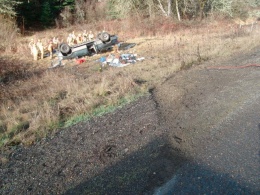
(Photo: Oregon State Police)
319 people died while traveling on Oregon roads in 2011; that’s two more than 2010 and the first increase since 2005. Another bit of preliminary data shows that 15 people on bicycles were killed last year — that’s a 114% increase from the seven lives lost in 2010 and it ties the highest bike fatality total since at least 2003.
The Oregon Department of Transportation (ODOT) updated their crash statistics after five people were killed over the New Year’s holiday. The 319th fatality happened on the morning of December 31st, when a 38-year old Vancouver, Washington mad died after losing control of his pickup while driving on icy roads Highway 20 near Philomath.
ODOT expects to have final 2011 numbers out in about a month; but preliminary data supplied to BikePortland today shows that of the 319 fatalities, 15 of them were people on bicycles, or “pedalcyclists” to use ODOT’s terminology. That number is the highest it’s been since at least 2003 (that’s as far back as I have seen ODOT bike-specific fatality statistics). 15 people on bikes also died in 2007, but there were 455 total fatalities that year (compared to 319 in 2011).
While the number of “pedalcyclists” more than doubled, the number of pedestrians killed fell to 45 from a high of 61 last year (read more about that 2010 uptick in a Q & A we shared with ODOT’s Traffic Safety Division manager last year).
In the past decade, 4,740 people have died while traveling on Oregon roads. Below is a year-by-year breakdown (bicycling fatalities are in parentheses):
- 2011 – 319 (15)
2010 – 317 (7)
2009 – 377 (8)
2008 – 416 (10)
2007 – 455 (15)
2006 – 478 (14)
2005 – 487 (11)
2004 – 456 (9)
2003 – 512 (8)
2002 – 436
2001 – 487
And here’s a chart with more yearly data taken from ODOT’s recently adopted Traffic Safety Action Plan (TSAP).
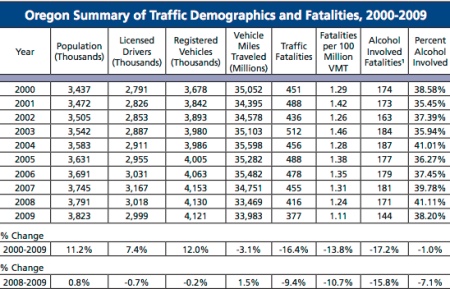
ODOT has made significant progress in traffic safety as fatality and injury rates have plummeted in past decades; but as we shared back in August, traffic crashes are still the leading cause of death in Oregon for people under 35 years of age and they cost our state an estimated $2.58 billion in total economic loss — or about $657 dollars per Oregon resident (according to the National Safety Council).
In October 2011, the State of Oregon officially adopted an update to their Traffic Safety Action Plan. That 94 page plan outlines a number of “Actions” and “Emphasis areas” such as toughening drunk driving laws, improving driver education programs and considering new legislation, “requiring the inclusion of helmets, reflective gear and lighting with new bicycles.”
In the plan’s Executive Summary, ODOT acknowledges that business as usual won’t result in a major reduction in fatalities:
“Moderate reductions in Oregon’s highway death toll can be continued through current programs, but a sustained, concentrated effort will prevent many crashes and save a significant number of lives and dollars.”
And of course there’s a lot of work to do if Oregon is to reach the vision of the future laid out in the plan:
“The Oregon Transportation Safety Action Plan envisions a future where Oregon’s transportation-related death and injury rate continues to decline. We envision a day when days, then weeks and months pass with not a single fatal or debilitating injury occurs. someday, we see a level of zero annual fatalities and few injuries as the norm.”
To learn more about what these numbers mean, stay tuned for more coverage and delve into them yourself via ODOT’s Crash Analysis & Reporting web page.



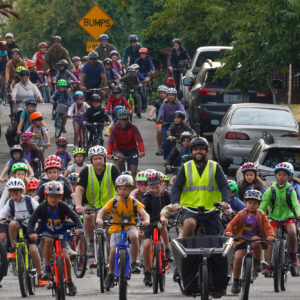
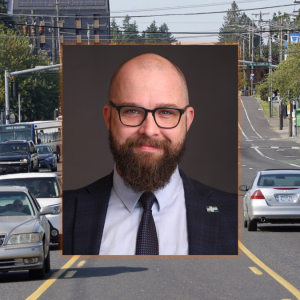
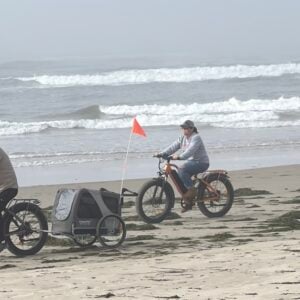
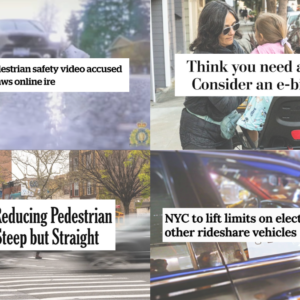
Thanks for reading.
BikePortland has served this community with independent community journalism since 2005. We rely on subscriptions from readers like you to survive. Your financial support is vital in keeping this valuable resource alive and well.
Please subscribe today to strengthen and expand our work.
Thanks very much for highlighting this issue, Jonathan.
Maybe someone should remind Amanda Fritz of these statistics in relation to her belief that pedalcyclists on downtown sidewalks are so disproportionately dangerous that she felt it worth withholding funding from bike infrastructure until cyclists did a better job of remonstrating their fellow cyclists.
Here’s the quote from a Dec. 7 bikeportland article:
“In August, she told us she would vote for the City’s federal funding request for a bike-sharing system only when, “I see bike riders using downtown streets and sidewalks in a safe manner.” She said she regularly sees “cyclists… endangering and harassing pedestrians” on the sidewalk and that, “The cycling community seems to be doing little or nothing to educate riders or reduce these dangerous behaviors.”
Small correction:
“In the past decade, 4,740 people have died while traveling on Oregon roads.”
the statistics show that was for the past 11 years.
Jonathan,
do you happen to know the number of pedestrians killed on our roads? Seeing those alongside the other numbers would be useful I’d think. I assume they are included in those tallies above?
Without trying to sound callous, but I’d like to see what the numbers say for 12 month periods not defined by calendar year. All other things remaining the same, deaths will increase if more bicycle miles are ridden—maybe the weather was nicer last year than 2010.
Given those numbers, there’s about 10.8 deaths per year, with anywhere from 7-14 deaths being within a standard deviation. If you don’t speak mathese, that’s only half the difference used to separate average intellect from genius/mental retardation.
“If you don’t speak mathese, that’s only half the difference used to separate average intellect from genius/mental retardation.”
What?
In statistics, you’re basically looking for proof that a change from your expected (not hoped) value is meaningful. Annual variation suggests that a 114% increase isn’t major in this particular dataset. However, somebody with a 214 IQ (where 100 is average) is a HUGE deal.
Oh I took statistics and understand deviations, it is your English and reasoning I was concerned about.
Or maybe in even more layman’s terms, wild percentage swings in those numbers are about as likely as flipping heads six times out of ten.
Riding in Oregon is as safe as it’s going to be. Expanded access would be a much better place to devote city/county/state resources.
I like your “math for the layperson”.
Why do you say “Riding in Oregon is as safe as it’s going to be.”?
It would take a pretty substantial investment in existing systems to make a significant dent in those numbers. Increasing the number of bike-friendly miles would be a much better way to spend money.
Translation of Champs: No evidence of a trend or a surprisingly large number.
More statistics: if deaths are roughly a Poisson process, with mean 10.8 per year, then neither 7 nor 15 is a surprising count.
To illustrate, here are three sequences of 9 observations from a Poisson distribution with mean 10.8:
> rpois(9,10.8)
[1] 15 12 9 9 8 12 15 10 9
> rpois(9,10.8)
[1] 9 8 11 20 12 9 12 11 14
> rpois(9,10.8)
[1] 10 17 9 9 5 9 14 9 21
Don’t let math and logic get in the way of a perfectly good alarmist headline!
How is that an “alarmist” headline?
319 people died. It’s the first increase since 2005 and there was a significant uptick in bike deaths.
I am not a math whiz, but the numbers are the numbers.
Trying hard to talk about these numbers without trivializing even a single fatality, I’ll note that the 319 deaths is literally an “increase” but statistically it’s a flat line from last year’s numbers.
In the same statistical (not moral) vein, it’s difficult to characterize uptick in bicycling deaths as “significant” because there’s such a small sample size — and there’s no context. Relative to past years, are there more or fewer cyclists? Are the total number of cycling miles and/or trips up or down? Are the number of reported crashes with serious injuries up or down?
Thanks Paul H.,
Those are good points. I will keep them in mind for future stories about statistics. And yes, I agree with you and other commenters that more context with with the numbers would be helpful… But it’s always a tricky balance when reporting stuff like this to not bore people with too many numbers, yet give them enough to fully understand what’s going on. Thanks,
i’ve always appreciated the links contained in many articles (previous stories, other info sources, etc.) as they help give a bigger picture of the issue at hand. adding links the drier material & statistics sources at the end of an article (that may not work well being written into the body of a story) would be great & i’ve seen this before.
It’s interesting that, although the number of registered vehicles has been increasing slightly, Vehicle Miles Traveled have been steadily decreasing through the decade. Why do we need the CRC again?
because we have the best government developers, relitters, banksters, and infestors can buy.
And because it’s the job of Oregon to ensure that Washington residents can avoid Oregon taxes by living just over the state line and commuting on Oregon roads paid for by Oregon citizens.
Avoiding taxes by working in Oregon?
Washington residents pay income tax on their earnings to Oregon, and don’t avail themselves of many of the services those taxes pay for.
Oregonians should be damned glad that a large number of Washington residents go home each night leaving behind tax revenue.
I think I’m missing something. How do they get back home? Are you imagining them to be biking back across the bridges? I suspect some do, but probably the majority do not. Around these parts, clogging up freeways sitting in a car is one of the chief ways to ‘avail oneself of many of the services’ we have here, not to mention the parking required to accommodate this.
And they use services that are payed for by property taxes, such as roads, and the Economic activity enabled by our property tax funded infrastructure.
It’s better to think of these people as Oregon workers that live in Washington. They could live in Oregon, but we have created infrastructure that enables them to live further away and across the state line.
Projects like the CRC are a huge subsidy to those that choose to live in the Vancouver suburbs, just as a new MAX line is a subsidy for residents living near the line. Quality of life in Portland is also degraded by the congestion and pollution these commuters create. We should not be spending our state’s money on anything that encourages this lifestyle choice.
Does anyone have stats on how many people died while riding a bicycle where the event did not involve a motor vehicle? I’d have to assume its a very low number.
I ask because it seems like that information would be very applicable in arguing for separated bikeways. Bicycling doesn’t kill people (often), collisions with vehicles kill people.
Jack,
I don’t think it is so simple. Blacks still had to walk past a lot of white folks to get to the back of the bus. People on bikes, even if they were on separated bikeways, would still have to cross auto traffic dozens (hundreds?) of times on a given trip.
I do agree that having a few more statistics for people on bikes and pedestrians, and broken out by whether or not the deaths involved cars, would be helpful.
The word ‘separated’ in ‘separated bikeway’ has nothing to do with ‘separate but equal’ racial discrimination. Please leave race out of the discussion.
Of course it doesn’t officially. But practically there are plenty of parallels. Think of it as a metaphor.
The point is, a separate set of bikeways isn’t the 1950s ‘everyone has their own helicopter 3-D fantasy’ where no traffic signals are required. These bikeways would cross the existing ‘whites only’ infrastructure everywhere since this is a 2-D surface we are talking about. As such I don’t really see the clearcut argument for safety from going this route.
Besides, by the time such an infrastructure were approved, funded, and built, we’ll all be riding bikes anyway, or getting around without fossil fuels for the most part, so striving for this strikes me as questionable on those grounds as well.
From the Portland 2030 Bike Plan:
“National data from the Federal Highway Administration indicates that 70 percent of bicycle injuries resulting in an emergency room visit do not involve a motor vehicle and that nearly 31 percent of crashes occurred on non-roadway locations (off-street paths). ”
That’s national data that probably involves higher-risk recreational riding. In Portland I recall PDOT saying about 50% of bike crashes involve a motor vehicle, and of those about 50% are the fault of the motor vehicle.
any idea on how these numbers on bike fatalities compare to ridership? feels like more people are riding every year, (tell me if that’s in fact true) then more people on bikes + more miles being logged would increase the chances of being in an accident…all other things being equal.
For cost/benefit calculations, the EPA considers a human life to be worth $7.9 million. So let’s see, 4,740 people killed by vehicles in the last decade gives more than $37 billion in “value to society” lost. Not to mention the emotional impact on loved ones. Seems like a reasonable fraction of that figure could go a long way toward improving infrastructure on the streets for all users, resulting in a net economic, societal, and emotional benefits.
The people and their representative government feel that 319 deaths is a small price to pay. Traffic fines for speeding were recently reduced and there is not the political will to enforce traffic laws.
Economics shows that if you increase the cost (ticket price) and increase enforcement, demand (traffic violations) will go down. And, since all traffic fatalities involve the illegal operation of a motor vehical, deaths will go down.
The math is simple, but the will is not.
Wrong city in the masthead pic.
I love that geeky trolls are accusing you of sexying up your headlines, Jonathan.
Every bicycle death this year, to me, was unexpected. And significant.
I don’t care how someone tries to minimize using z-scores, logs, or integrals, 15 lives is more than double 7 lives. Is significant. And is a jaw-stopping reverse to a three-year downward trend. And is also a variance of 8, year over year, the highest variance noted in the data provided. Thank you for your concern and writing about this.
The thing that stood out here to me in your report, though, was the recommendation about reflective gear, helmets, and lighting. Interference with the free market, consumer choice, and adding about $100 to the retail price of a bike? Um, BAD idea.
And I am a helmet advocate.
We need a blogger like Bill Nye: The Statistics Guy.
15 deaths is too many, but a single year in Oregon is too small a sample to tell us (on its own) whether a trend is going on. Expand to the nation as a whole, though, and the trend is clear:
1. Death rates of people IN motor vehicles continue a substantial and steady decline thanks to mind-boggling improvements in automotive safety.
2. Death rates of people OUTSIDE motor vehicles (both pedestrians and cyclists) continue to hold steady or rise slightly. Cars may be getting safer, but drivers are getting more dangerous: more aggressive and more distracted.
I’d be interested in hearing how this stacks up to fatalities per miles traveled.
I would bet that per distance traveled, bike travel will always come out more “dangerous”, simply because the miles traveled are so much lower than for a car; car travel incidents per mile are “diluted” by the massively higher number of miles they travel. To me, the best indication of statistical “safety” for a mode is a per trip measurement. A “trip” has to be well-defined, but I think this creates a more apples-to-apples comparison of relative safety between travel modes.
Thanks for showing the data. I agree with the other commenters that statistically the current numbers are pretty much in line with the trend. I think the headline and tone of the article were appropriate.
Some additional context that is think would be very interesting is if the bicycle deaths occurred in areas where there are lots of bike infrastructure (like in Portland). The real question is how much does investing in bike specific infrastructure reduce bike fatalities. We would also have to account for bike miles traveled in different areas because obviously areas with good infrastructure have more bike activity and more opportunity for collisions. This data may not exist, but if it does it would be cool to put it all together and see it.